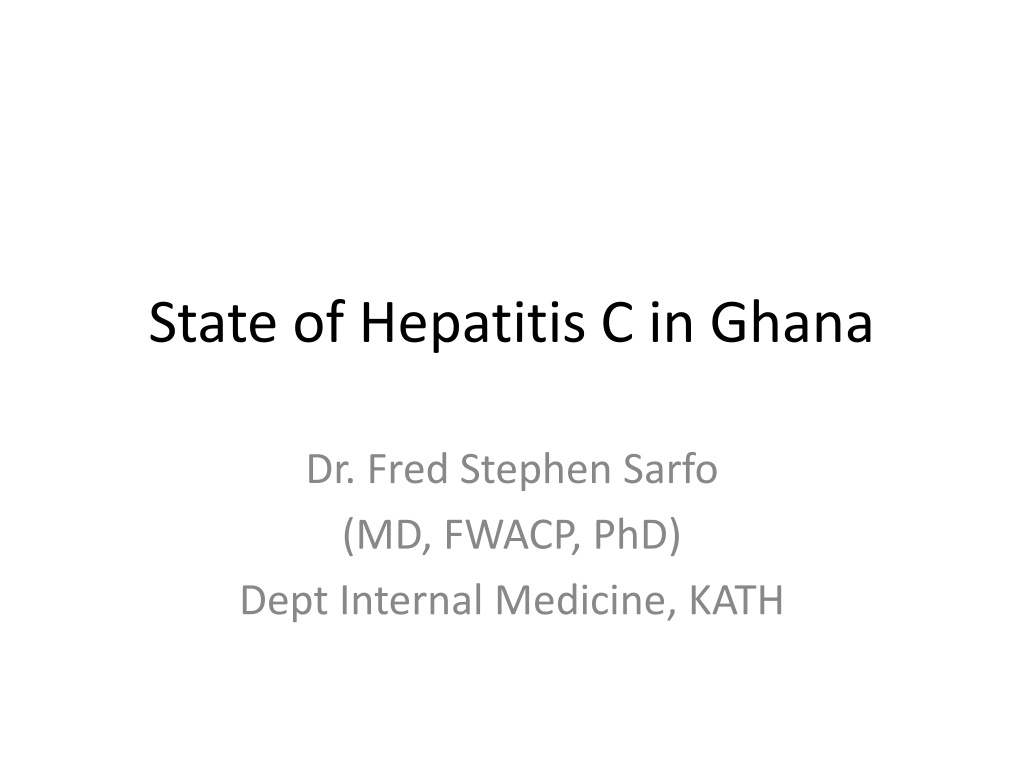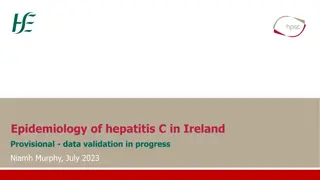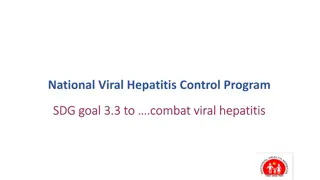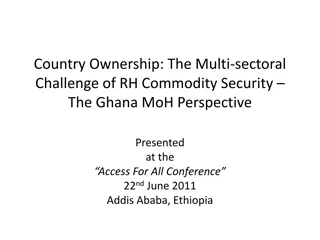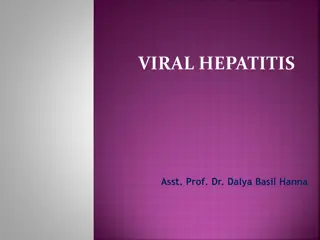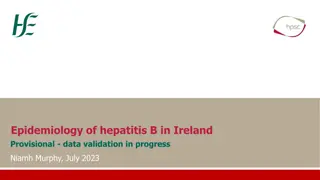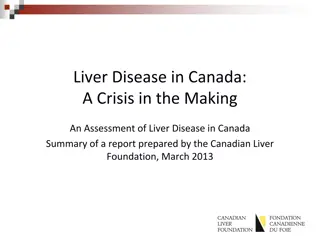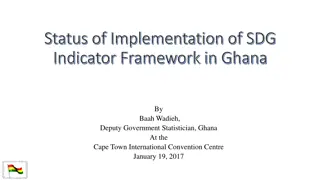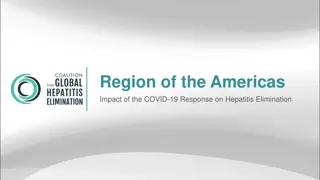Overview of Hepatitis C Epidemiology in Ghana by Dr. Fred Stephen Sarfo
Dr. Fred Stephen Sarfo's research on Hepatitis C in Ghana reveals a notable sero-prevalence of the virus across various populations such as blood donors, prisons inmates, and more. The studies show varying HCV antibody frequencies, highlighting the need for continued surveillance and targeted interventions. Risk factors among prison inmates like longer incarceration and history of IV drug use further emphasize the complexity of HCV transmission in Ghana.
Download Presentation

Please find below an Image/Link to download the presentation.
The content on the website is provided AS IS for your information and personal use only. It may not be sold, licensed, or shared on other websites without obtaining consent from the author. Download presentation by click this link. If you encounter any issues during the download, it is possible that the publisher has removed the file from their server.
E N D
Presentation Transcript
State of Hepatitis C in Ghana Dr. Fred Stephen Sarfo (MD, FWACP, PhD) Dept Internal Medicine, KATH
HCV in Africa Karoney et al., 2013
HCV in West Africa Karoney et al., 2013
Sero-prevalence of HCV in Ghana PUBMED Search, 33 articles Excluded 17 articles Included 16 articles Blood donors, n=9 studies Prisons, n=3 studies Obstetrics & Gynae, n=3 studies HIV na ve, n=1 study School children, n=1 study Excluded 2 studies
Sero-prevalence of HCV in Ghana First Author Year Location Population Sample size HCV Ab frequency Study No. 1 Damango, NR Blood donors 819 6.1% Kubio C 2012 2012 2 KBTH, GAR HIV Naive 138 3.6% Sagoe KW, 3 2011 Ashanti Akim N. AR Blood doors 2773 9.4% Nkrumah B Allain JP 4 2009 KATH, AR Blood donors 51,000 0.45% 5 Adjei AA 2007 Multicentre Prison inmates 1336 18.7% 6 Apea-Kubi 2006 KBTH, GAR OB & GY OPD 638 5.2% 7 Adjei AA 2006 Multicentre Prisons inmate Prison officers 218 82 19.2% 23.2% 8 Lassey AT 2004 KBTH, GAR OB & GY delivery 638 2.5% 9 Candotti D 2003 KATH, AR Blood donors 4,984 1.3% 10 Ampofo W 2002 NMIMR, GAR Blood donors 808 8.4% 11 Sarkodie F 2001 KATH, AR Blood donors 45,000 0.3% 12 Acquaye JK 2000 KBTH, GAR Blood donors 1,300 5.2% 13 Candotti D 2001 KBTH, AR BD Replacement BD volunteers 1,569 1,169 1.7% 0.7% 14 Martinson 1996 Ashanti Akim N. AR School children 803 5.4%
Sero-prevalence among specific populations Population Number of studies Sample size Average HCV Ab frequency Range Prisons 3 1,636 19.0% 18.7% - 23.2% School children 1 803 5.4% 5.4% OB & GY 2 1,155 3.7% 2.5% - 5.2% HIV Na ve 1 138 3.6% 3.6% Blood donors 9 109,422 0.8% 0.7% - 9.4%
Risk factors in Ghana Adjei et al. (2007), identified the following risk factors among prison inmates Risk factor Adjusted OR 95% CI Longer incarceration > median time served of 36 months 5.8 5.0 6.9 Hx of IV drug use 4.5 3.8 5.4 Homosexuality 3.1 2.5 3.9
Risk factors in Ghana Adjei et al. (2008) identified the following among prison inmates/officers: 1. Age 17-46 years 2. Female gender 3. Being unmarried 4. Hx of sexually transmitted diseases 5. Hx of participation in paid sexual activity 6. Hx of sharing in drug paraphernalia
Genotypes of HCV in Ghana There are 6 phylogenetic distinct genotypes:1-6 Many subtypes: a, b, c 100 different strains: 1,2,3 etc based on the sequence of the HCV genome Genotypes 1-3 have world-wide distribution In Ghana, genotype 2 (87%) is commonest, genotype 1 (13%) (Wansbrough-Jones et al., 1998; Candotti et al.2003)
Phylogenetic relationship between HCV E1/E2 sequences in 23 Ghanaian strains and 31 reference sequence Candotti et al. 2003
Phylogenetic relationship between HCV NS5B sequences in 23 Ghanaian strains and 31 reference sequences Candotti et al. 2003
Disease progression and presentation HCV disease progression not well studied in Ghana Clearance driven by viral and host factors Likely that there is higher spontaneous clearance of genotype 2 among Ghanaians. Candotti et al. reported that at least 53% of anti-HCV carriers had no detectable HCV RNA among blood donors
Disease progression and presentation Ghanaian viremic HCV blood donors had significantly lower viral loads than UK cohort
Disease progression and presentation Host factors important in clearance of HCV are humoral and cellular immunity
Cellular immunity and host genetics Cheung et al. studied the cellular immune response to HCV among Ghanaians using ELISPOT and found ff responses 12 / 24 (50%) confirmed recovered 1 / 5 (20%) chronically infected 0 / 6 (0%) false positive HLA-B*57 was more frequent among those recovered than chronically infected (OR=8.02, p=0.005)
Clinical presentation What is the prevalence of HCV among individuals with 1. Transaminitis (2 out of 68 with HCV Ab).Acquaye et al. 2. Liver cirrhosis 3. Hepatocellular carcinoma 4. Chronic kidney disease 5. HIV co-infected patients 6. Hepatotoxicity on ART and Anti-TB medications 7. Patients on dialysis
Management of HCV infection Indications for treatment All patients with HCV are potential candidates for treatment Those at risk of developing cirrhosis evidenced by Measurable HCV RNA viral load and liver biopsy showing portal or bridging fibrosis along with moderate inflammation and necrosis.
Recommended treatment regimens for HCV infection Medication Dose Duration Acute infection Interferon (IFN) 6MU IM/SC x 3/week 36 weeks PEG Interferon 180 mcg weekly 48 weeks Chronic infection Interferon 3MU IM/SC x 3/week 24 months Ribavirin 800-1200mg PO bd 24-48 weeks Newer agents such as Sofosbuvir, Boceprevir and Telaprevir not available. They could be studied in this population to assess their efficacy Treatment outcomes of HCV in Ghana not well described
Research questions for HEPNet There is a clear need for an integrated approach to HCV research in Ghana (Africa) We need to understand 1. Transmission 2. Prevalence in the community 3. Natural history of HCV genotype 2 4. Host and genetic factors involved in HCV pathogenesis 5. Burden of disease 6. Impact on HIV outcomes 7. Treatment outcomes 8. Test newer agents on pilot basis to assess their efficacy
